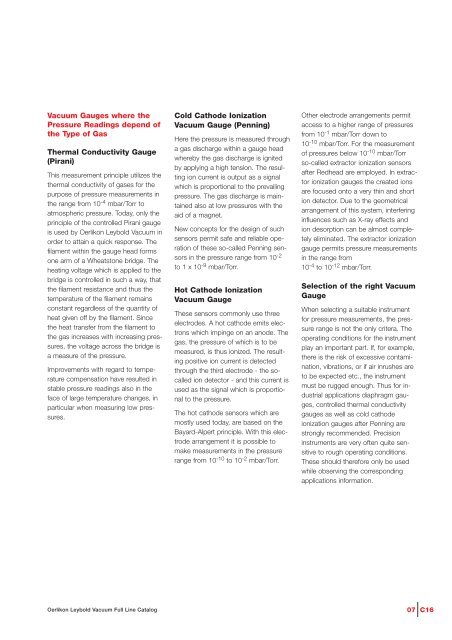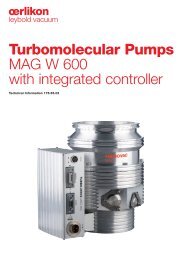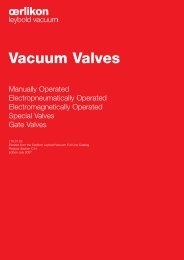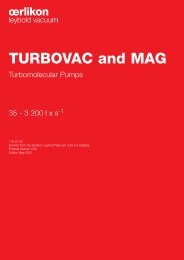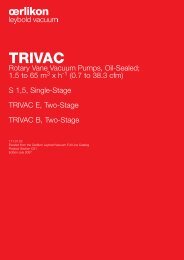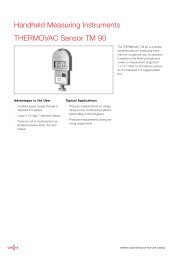Total Pressure Gauges
Total Pressure Gauges
Total Pressure Gauges
Create successful ePaper yourself
Turn your PDF publications into a flip-book with our unique Google optimized e-Paper software.
Vacuum <strong>Gauges</strong> where the<br />
<strong>Pressure</strong> Readings depend of<br />
the Type of Gas<br />
Thermal Conductivity Gauge<br />
(Pirani)<br />
This measurement principle utilizes the<br />
thermal conductivity of gases for the<br />
purpose of pressure measurements in<br />
the range from 10 -4 mbar/Torr to<br />
atmospheric pressure. Today, only the<br />
principle of the controlled Pirani gauge<br />
is used by Oerlikon Leybold Vacuum in<br />
order to attain a quick response. The<br />
filament within the gauge head forms<br />
one arm of a Wheatstone bridge. The<br />
heating voltage which is applied to the<br />
bridge is controlled in such a way, that<br />
the filament resistance and thus the<br />
temperature of the filament remains<br />
constant regardless of the quantity of<br />
heat given off by the filament. Since<br />
the heat transfer from the filament to<br />
the gas increases with increasing pressures,<br />
the voltage across the bridge is<br />
a measure of the pressure.<br />
Improvements with regard to temperature<br />
compensation have resulted in<br />
stable pressure readings also in the<br />
face of large temperature changes, in<br />
particular when measuring low pressures.<br />
Cold Cathode Ionization<br />
Vacuum Gauge (Penning)<br />
Here the pressure is measured through<br />
a gas discharge within a gauge head<br />
whereby the gas discharge is ignited<br />
by applying a high tension. The resulting<br />
ion current is output as a signal<br />
which is proportional to the prevailing<br />
pressure. The gas discharge is maintained<br />
also at low pressures with the<br />
aid of a magnet.<br />
New concepts for the design of such<br />
sensors permit safe and reliable operation<br />
of these so-called Penning sensors<br />
in the pressure range from 10 -2<br />
to 1 x 10 -9 mbar/Torr.<br />
Hot Cathode Ionization<br />
Vacuum Gauge<br />
These sensors commonly use three<br />
electrodes. A hot cathode emits electrons<br />
which impinge on an anode. The<br />
gas, the pressure of which is to be<br />
measured, is thus ionized. The resulting<br />
positive ion current is detected<br />
through the third electrode - the socalled<br />
ion detector - and this current is<br />
used as the signal which is proportional<br />
to the pressure.<br />
The hot cathode sensors which are<br />
mostly used today, are based on the<br />
Bayard-Alpert principle. With this electrode<br />
arrangement it is possible to<br />
make measurements in the pressure<br />
range from 10 -10 to 10 -2 mbar/Torr.<br />
Other electrode arrangements permit<br />
access to a higher range of pressures<br />
from 10 -1 mbar/Torr down to<br />
10 -10 mbar/Torr. For the measurement<br />
of pressures below 10 -10 mbar/Torr<br />
so-called extractor ionization sensors<br />
after Redhead are employed. In extractor<br />
ionization gauges the created ions<br />
are focused onto a very thin and short<br />
ion detector. Due to the geometrical<br />
arrangement of this system, interfering<br />
influences such as X-ray effects and<br />
ion desorption can be almost completely<br />
eliminated. The extractor ionization<br />
gauge permits pressure measurements<br />
in the range from<br />
10 -4 to 10 -12 mbar/Torr.<br />
Selection of the right Vacuum<br />
Gauge<br />
When selecting a suitable instrument<br />
for pressure measurements, the pressure<br />
range is not the only critera. The<br />
operating conditions for the instrument<br />
play an important part. If, for example,<br />
there is the risk of excessive contamination,<br />
vibrations, or if air inrushes are<br />
to be expected etc., the instrument<br />
must be rugged enough. Thus for industrial<br />
applications diaphragm gauges,<br />
controlled thermal conductivity<br />
gauges as well as cold cathode<br />
ionization gauges after Penning are<br />
strongly recommended. Precision<br />
instruments are very often quite sensitive<br />
to rough operating conditions.<br />
These should therefore only be used<br />
while observing the corresponding<br />
applications information.<br />
Oerlikon Leybold Vacuum Full Line Catalog<br />
07 C16


